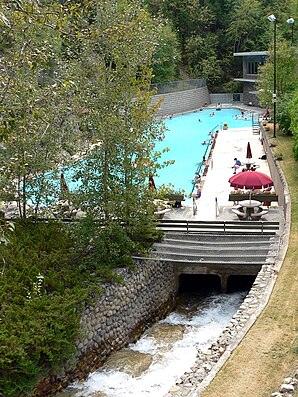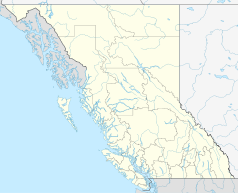Radium Hot Springs
| Radium Hot Springs | ||
|---|---|---|
 Bathing pool at the Radium Hot Springs |
||
| Location in British Columbia | ||
|
|
||
| State : |
|
|
| Province : | British Columbia | |
| Regional District : | East Kootenay | |
| Coordinates : | 50 ° 37 ′ N , 116 ° 4 ′ W | |
| Height : | 808 m | |
| Residents : | 777 (as of 2011) | |
| Time zone : | Mountain Time ( UTC − 7 ) | |
| Foundation : | 1990 (incorporated) | |
| Website : | www.radiumhotsprings.ca | |
Radium Hot Springs is a municipality in the Canadian province of British Columbia . The place is in the valley of the Columbia River at the junction of Highway 95 and Highway 93 . The place is surrounded by the Purcell Mountains in the west and the Rocky Mountains in the east and is located at the exit of Sinclair Canyon, the southern entrance of Kootenay National Park . The main source of income for the community is the timber industry, but tourism also plays an important role. Numerous visitors come to the eponymous hot springs to enjoy a bath in the slightly radioactive hot springs.
history
The hot springs were already known to the First Nations . The first bather known by name was George Simpson , the governor of the Hudson's Bay Company , who took a bath in the hot spring water in a gravel basin in 1841. In 1890, the Englishman Roland Stuart acquired the hot spring site. By 1914 a swimming pool and a first bath house had been built. Due to the First World War, the expansion stalled until tourism took off considerably with the establishment of the Kootenay National Park in 1920 and the opening of the Banff-Windermere Highway. In 1920 the Canadian Pacific Railway built the Radium Hot Springs Lodge , which was soon followed by other hotels. The Canadian government took over the hot springs in 1922 and expanded the bathing facilities. After the Second World War , the bathing facilities were expanded, and the town grew rapidly due to increasing tourism.
The granting of local self-government for the municipality, incorporated as Village Municipality , took place on December 10, 1990.
Demographics
The 2011 census showed a population of 777 inhabitants for the small community. The city's population has increased by 5.7% compared to the 2006 census, while the population in the province of British Columbia grew by 7.0% at the same time.
nature
The place lies on the Columbia River, whose wet meadows are the largest in North America. The Wings over the Rockies bird festival is celebrated annually in May and attracts bird watchers from all over the world.
Hot springs
Due to its location at the Rocky Mountain Trench, groundwater seeps into the earth's crust to a depth of over 2,400 meters, where it is heated to the boiling point. The water vapor rises to the surface of the earth through cracks in folds, cooling down along the way, so that the water comes to the surface at a temperature of 44 ° C. On its way through the earth's crust, the water is enriched with minerals and gases, at the Radium Hot Springs, among other things, with weakly radioactive radon . Studies have shown that it takes three months for the water to come to the surface again warmed up. The radioactivity of the water was proven back in 1913, and the springs have been used as thermal baths since 1914. They were an important reason for the establishment of the Kootenay National Park and were therefore included in the park. Today the pool consists of two larger outdoor pools, a 39 ° C pool, which is considered the largest thermal pool in Canada, and a larger, 27 ° C pool.
Web links
Individual evidence
- ↑ Statistics Canada (2011 Census). Radium Hot Springs Community Profile
